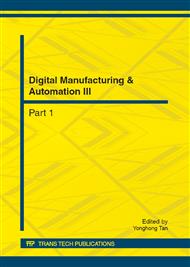p.93
p.97
p.101
p.106
p.111
p.115
p.121
p.126
p.133
Modeling and Performance Analysis for Cluster Tools Based on SPN
Abstract:
For analysis the performance of cluster tools, Stochastic Petri nets model was used to describe the serial process procedure of cluster tools and the operation sequence of the robot. The firing rate of transition represents the frequency of activities. In order to improve the scalability of the model, the modular approach is used to model. Firstly the sub-models of tool’s modules were developed. Then according to the process procedure, all the sub-models were combined to construct a Petri nets model. Finally, the firing rates are added to every transition. Markov process approach was used to analyze model. Some performance measures equation are deduced, such as the throughput, the utilization of process chamber, the utilization of the robot and the wafer residency rate in process chamber. Petri nets models and performance measures equation developed in paper can assist performance analysis and verify the effectiveness of scheduling algorithm.
Info:
Periodical:
Pages:
111-114
Citation:
Online since:
July 2012
Authors:
Keywords:
Price:
Сopyright:
© 2012 Trans Tech Publications Ltd. All Rights Reserved
Share:
Citation:


